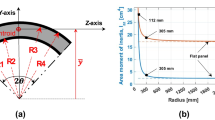Abstract
In this paper, the stress analysis of the most critical beam–arch joint of Yuehu Bridge is conducted, despite the variation in the specific structure of each tied arch bridge. To achieve this, two specimens with different scale ratios were designed. The smaller specimen was used to consider the effect of bridge deck and loading to failure. The experimental results indicate that both specimens did not exhibit significant deformation under the design load, and the measuring point’s stress was located in the elastic section. This implies that the original bridge structure design is rational. However, the arch rib steel plate of the 1/8 scale specimen buckled when subjected to 1.8 times the design load. To validate the experimental results, a finite element model that considers the elastoplastic behavior of the material was established and compared with the experimental results. The comparison shows that the finite element model can predict the mechanical behavior of the structure effectively, thus confirming the rationality of the structure design. Additionally, the study also analyzed the buckling problem of tied arch bridges, which is another critical issue. The in-plane and out-of-plane buckling of fixed and hinged parabolic arches under uniform axial compression were investigated. The results demonstrate that the boundary conditions, rise-span ratio, and bridge deck width significantly affect the buckling performance. Overall, this study provides essential insights into the stress and buckling behavior of tied arch bridges, which can guide the design and construction of such structures in the future.























Similar content being viewed by others
Data availability
Data will be made available on request.
References
Bayraktar A, Türker T, Altunişik AC. Experimental frequencies and damping ratios for historical masonry arch bridges. Constr Build Mater. 2015;75:234–41. https://doi.org/10.1016/j.conbuildmat.2014.10.044.
Kang HJ, Zhao YY, Zhu HP, Jin YX. Static behavior of a new type of cable-arch bridge. J Constr Steel Res. 2013;81:1–10. https://doi.org/10.1016/j.jcsr.2012.10.010.
Ma H, Zheng H, Zhang W, Tang Z, Lui EM. Experimental and numerical study of mechanical behavior of welded steel plate joints. Metals. 2020;10:1293. https://doi.org/10.3390/met10101293.
Ye M, Huang Q, Wu Q. Analysis of steel-concrete composite structure with overlap slab of Xingguang bridge. J Cent South Univ Technol. 2007;14:120–4. https://doi.org/10.1007/s11771-007-0024-1.
Huynh CP, Mustapha S, Runcie P, Porikli F. Multi-class support vector machines for paint condition assessment on the Sydney Harbour Bridge using hyperspectral imaging. Struct Monit Maint. 2015;2:181–97. https://doi.org/10.12989/smm.2015.2.3.181.
Fan B, Wang S, Chen B. Dynamic effect of tie-bar failure on through tied arch bridge. J Perform Constr Facil. 2020;34:04020089. https://doi.org/10.1061/(ASCE)CF.1943-5509.0001492.
Feng Y. Research and scale model test on the local stability of steel box arch segment of Lupu Bridge. In: Shen ZY, Li GQ, Chan SL, editors. Fourth international conference on advances in steel structure. Oxford: Elsevier Science Ltd; 2005. p. 1663–7. https://doi.org/10.1016/B978-008044637-0/50248-1.
Zhang K-B, Zhang J-R, Yan D-H. Model test of half-through CFST tied-arch bridge in the process of arch rib erection. Struct Eng Int. 2008;18:396–402. https://doi.org/10.2749/101686608786455199.
Liu A-R, Huang Y-H, Fu J-Y, Yu Q-C, Rao R. Experimental research on stable ultimate bearing capacity of leaning-type arch rib systems. J Constr Steel Res. 2015;114:281–92. https://doi.org/10.1016/j.jcsr.2015.08.011.
La Poutré DB, Spoorenberg RC, Snijder HH, Hoenderkamp JCD. Out-of-plane stability of roller bent steel arches—an experimental investigation. J Constr Steel Res. 2013;81:20–34. https://doi.org/10.1016/j.jcsr.2012.11.004.
Wei J, Wu Q, Chen B, Wang T-L. Equivalent beam-column method to estimate in-plane critical loads of parabolic fixed steel arches. J Bridge Eng. 2009;14:346–54. https://doi.org/10.1061/(ASCE)1084-0702(2009)14:5(346).
Guo Y-L, Zhao S-Y, Pi Y-L, Bradford MA, Dou C. An experimental study on out-of-plane inelastic buckling strength of fixed steel arches. Eng Struct. 2015;98:118–27. https://doi.org/10.1016/j.engstruct.2015.04.029.
Lu Y, Cheng Y, Han Q. Experimental investigation into the in-plane buckling and ultimate resistance of circular steel arches with elastic horizontal and rotational end restraints. Thin-Walled Struct. 2017;118:164–80. https://doi.org/10.1016/j.tws.2017.05.010.
Huang Y, Liu A, Zhu C, Lu H, Gao W. Experimental and numerical investigations on out-of-plane ultimate resistance of parallel twin-arch under uniform radial load. Thin-Walled Struct. 2019;135:147–59. https://doi.org/10.1016/j.tws.2018.10.042.
Laterza M, et al. Stress-life curves method for fatigue assessment of ancient brick arch bridges. Int J Archit Herit. 2017;11(6):843–58. https://doi.org/10.1080/15583058.2017.1315621.
Casamassima VM, D’Amato M. Fatigue assessment and deterioration effects on masonry elements: a review of numerical models and their application to a case study. Front Built Environ. 2019;5(65):1–10. https://doi.org/10.3389/fbuil.2019.00065.
D’Amato M, et al. Seismic performance evaluation of a multi-span existing masonry arch bridge. Open Civ Eng J. 2017;11(11):1191–207. https://doi.org/10.2174/1874149501711011191.
Ministry of housing and urban-rural development of China. Standard for design of steel structures. Beijing: GB 50017 Architecture and Building Press; 2017.
Industry Standard of the People's Republic of China. Technical specifications of urban pedestrian overcrossing and underpass. Beijing: CJJ 69-1995 China Architecture and Building Press. 1996.
Pi YL, Nicholas ST. In-plane inelastic buckling and strengths of steel arches. J Struct Eng. 1996;122(7):734–47.
Ministry of housing and urban-rural development of China. Technical specification for steel arch structure. Beijing: JGJ/T 249 Architecture and Building Press; 2011.
Acknowledgements
The work described in this paper is supported by grants from the Natural Science Foundation of Fujian Province (no. 2021J011062).
Author information
Authors and Affiliations
Corresponding author
Ethics declarations
Conflict of interest
All authors confirm that they have no conflicts of interest.
Ethical approval
All authors approve that the research was performed under all the ethical norms.
Consent to publish
All authors consent to publish this paper.
Consent to participate
Not applicable.
Additional information
Publisher's Note
Springer Nature remains neutral with regard to jurisdictional claims in published maps and institutional affiliations.
Rights and permissions
Springer Nature or its licensor (e.g. a society or other partner) holds exclusive rights to this article under a publishing agreement with the author(s) or other rightsholder(s); author self-archiving of the accepted manuscript version of this article is solely governed by the terms of such publishing agreement and applicable law.
About this article
Cite this article
Yang, Y., Lin, B. & Zhang, W. Experimental and numerical investigation of an arch–beam joint for an arch bridge. Archiv.Civ.Mech.Eng 23, 101 (2023). https://doi.org/10.1007/s43452-023-00645-3
Received:
Revised:
Accepted:
Published:
DOI: https://doi.org/10.1007/s43452-023-00645-3




